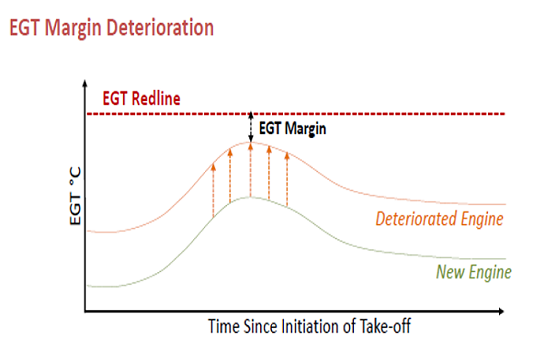Supporting Engine Condition Trend Monitoring (ECTM) Sofema Aviation Services looks at reasons why an Aircraft Engine is taken “Off Wing” for Maintenance Activities.
Technical drivers of off‐wing engine maintenance can essentially be broadly categorized into four areas:
EGT Margin Deterioration
Engines are typically certified with temperature limits enforced via a limit on maximum take‐off EGT, referred to as the redline EGT.
EGT Margin (EGTM) is the difference between the peak EGT incurred during take‐off and the certified redline EGT. It is used to evaluate and track engine time on‐wing & health.
EGT Margin °C = EGT Redline – EGT Take‐off
As would normally be expected the value of the EGT margins (EGTM) are at their highest levels when the engines are new or just following refurbishment. As the engine deteriorates, the EGT margin will rise until it reaches Redline EGT, or the absolute temperature limit which cannot be exceeded without damaging the engine
EGT Margin Deterioration largely results from hardware distress (e.g. gradual increase in clearance between turbine blade tips & surrounding static seals or shrouds, and combustor distress)
Rates of EGTM deterioration are highest during initial operation & subsequently stabilize to reach a steady state level.
Influencers for the Rate of Deterioration
Rate of EGTM deterioration is typically influenced by:
a) Flight Operational Activities
The rate of EGTM deterioration increases as engine thrust rating increases
The use of engine derate decreases
The reduction in the average flight leg length decreases (means more cycles)
b) Operating environment becomes more severe
c) Engine Age (Maturity)
In Service Deterioration – As would be expected – First‐run engines traditionally have higher EGTM and lower EGTM deterioration rates relative to mature engines/
Engine Condition Trend Monitoring (ECTM) of Exhaust Gast Temperature Margin (EGTM) trend monitoring looks at progressive deterioration to facilitate the analysis of the wear trend of engines.
Expiry of Life‐Limited Parts (LLPs)
Within the various engine modules are certain parts that cannot be contained if they fail, and as such are governed by the number of flight cycles operated.
These parts are known as Life‐Limited Parts (LLP) and generally consist of disks, seals, spools, and shafts.
LLPs are considered scrap and are discarded once their useful lives are reached.
LLPs account for a high proportion of the maintenance costs on short‐haul operations due to lower avg. flight legs & higher cycle accumulation
LLPs account for a low proportion of maintenance costs on long‐haul operations due to higher avg. flight legs & lower cycle accumulation
Hardware Deterioration
Other Removal Causes (typically unplanned events)
All engine components are exposed to different kinds of deterioration mechanisms.
These include amongst other factors
a) Low and high cycle fatigue
b) Thermo‐mechanical fatigue
c) Erosion
d) Corrosion
e) Oxidation
Other Removal Causes
Additional reasons for removal include amongst others:
a) Foreign Object Damage (FOD),
b) Oil Leak
c) High Oil Consumption
d) Vibration
e) Airworthiness Directives
Sofema Aviation Services offers EASA Compliant Regulatory and Vocational Training including Engine Condition Trend Monitoring. For details please see www.sassofia.com or email office@sassofia.com





